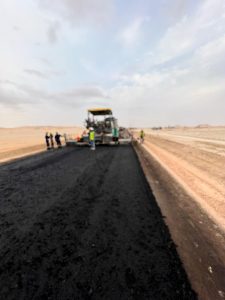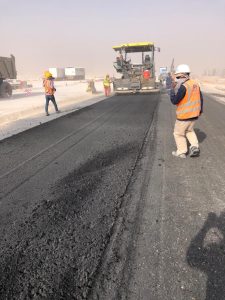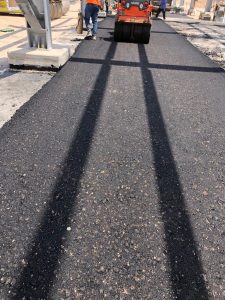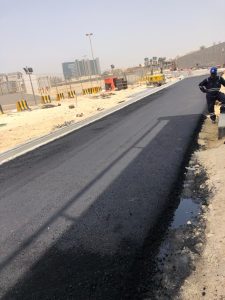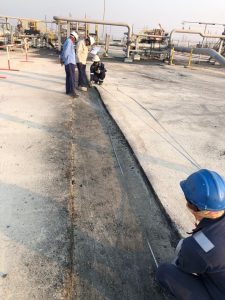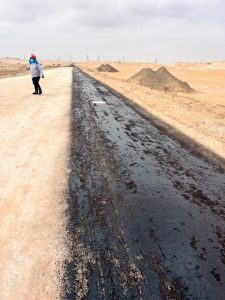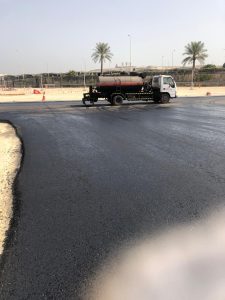
Asphalt Works
Asphalt is a mixture of aggregates, binder and filler, used for constructing and maintaining roads, parking areas, railway tracks, ports, airport runways, bicycle lanes, sidewalks and also play- and sport areas.
Aggregates used for asphalt mixtures could be crushed rock, sand, gravel or slags. Nowadays, certain waste and by-products, such as construction and demolition debris, are being used as aggregates, which increases the sustainability of asphalt.
In order to bind the aggregates into a cohesive mixture a binder is used. Most commonly, bitumen is used as a binder, although nowadays, a series of bio-based binders are also under development with the aim of minimising the environmental impact of the roads.
Asphalt mixtures can be produced at different temperatures
Hot Mix Asphalt (HMA)
Hot asphalt mixes are generally produced at a temperature between 150 and 180 °C. Depending on the usage, a different asphalt mixture can be used.
Warm Mix Asphalt (WMA)
A typical WMA is produced at a temperature around 20 – 40 °C lower than an equivalent Hot Mix Asphalt. Significantly less energy is involved and, consequently, less fumes are produced (as rule of thumb, a reduction of 25ºC produces a reduction of 75% of fumes emission). In addition, during the paving operations, the temperature of the material is lower, resulting in improved working conditions for the crew and an earlier opening of the road.
Cold Mix Asphalt
Cold mixes are produced without heating the aggregate. This is only possible, due to the use of bitumen emulsified in water, which breaks either during compaction or during mixing. Producing the coating of the aggregate. Over the curing time, water evaporates and strength increases. Cold mixes are particularly recommendable for lightly trafficked roads.
Different asphalt layers
An asphalt pavement consists of different asphalt layers. In general the asphalt layers are paved on a bound or unbound road base layer. Starting at the road surface, the first layer is called the surface course. The second layer is mostly called the binder course. The lower layers are the base courses.
Surface course
The surface course constitutes the top layer of the pavement and should be able to withstand high traffic- and environmentally-induced stresses without exhibiting unsatisfactory cracking and rutting. Its main mission is to provide an even profile for the comfort of the user, while providing enough texture to ensure minimum and safe skid resistance. Depending on local conditions, functional characteristics such as skid resistance, noise reduction and durability are often required for wearing courses. In some cases, rapid drainage of surface water is desired while in other cases, the wearing course should be impermeable in order to keep water out of the pavement structure. A wide range of surface layer products can be used depending on specific requirements. Surface layers types are:
Asphalt Concrete (AC)
Béton Bitumineux Mince (Thin Layer Asphalt Concrete – AC-TL)
Asphalt Concrete Very Thin Layers (AC-VTL)
Asphalt Concrete Ultra Thin Layer (AC-UTL)
Stone Mastic Asphalt (SMA)
Hot Rolled Asphalt (HRA)
Porous Asphalt (PA)
Double layered Porous Asphalt (2L PA)
Mastic Asphalt (MA)
Soft Asphalt (SA)
Binder course
Binder courses are designed to withstand the highest shear stresses that occur about 50 – 70 mm below the asphalt surface. The binder course is therefore placed between the surface course and base course to reduce rutting by combining qualities of stability and durability. Stability can be achieved by sufficient stone-on-stone contact and stiff and/or modified binders.
Base course
The base course is perhaps the most important structural layer of the pavement, which is intended to effectively distribute traffic and environmental loading in such a way that underlying unbound layers are not exposed to excessive stresses and strains. This often implies comparatively high stiffness of the base course. Next to this the base course should also show adequate fatigue resistance.
Unbound materials and foundation
Since the formation and sub-soil often constitute relatively weak materials, it is of utmost importance that the damaging loadings are effectively eliminated by the layers above. In this case, unbound road-base or sub-base layers consisting of uncrushed or crushed aggregate can be suitable.


